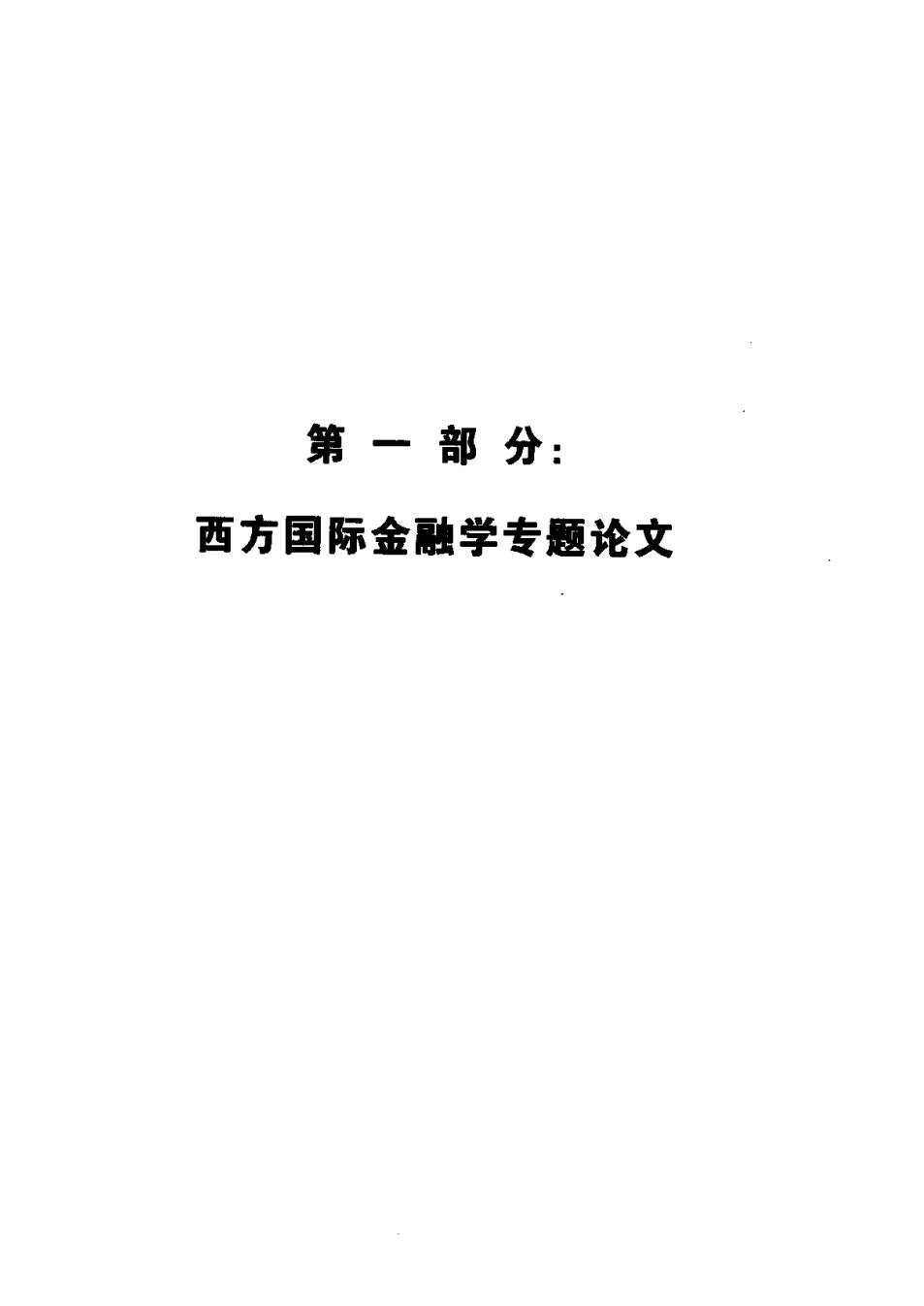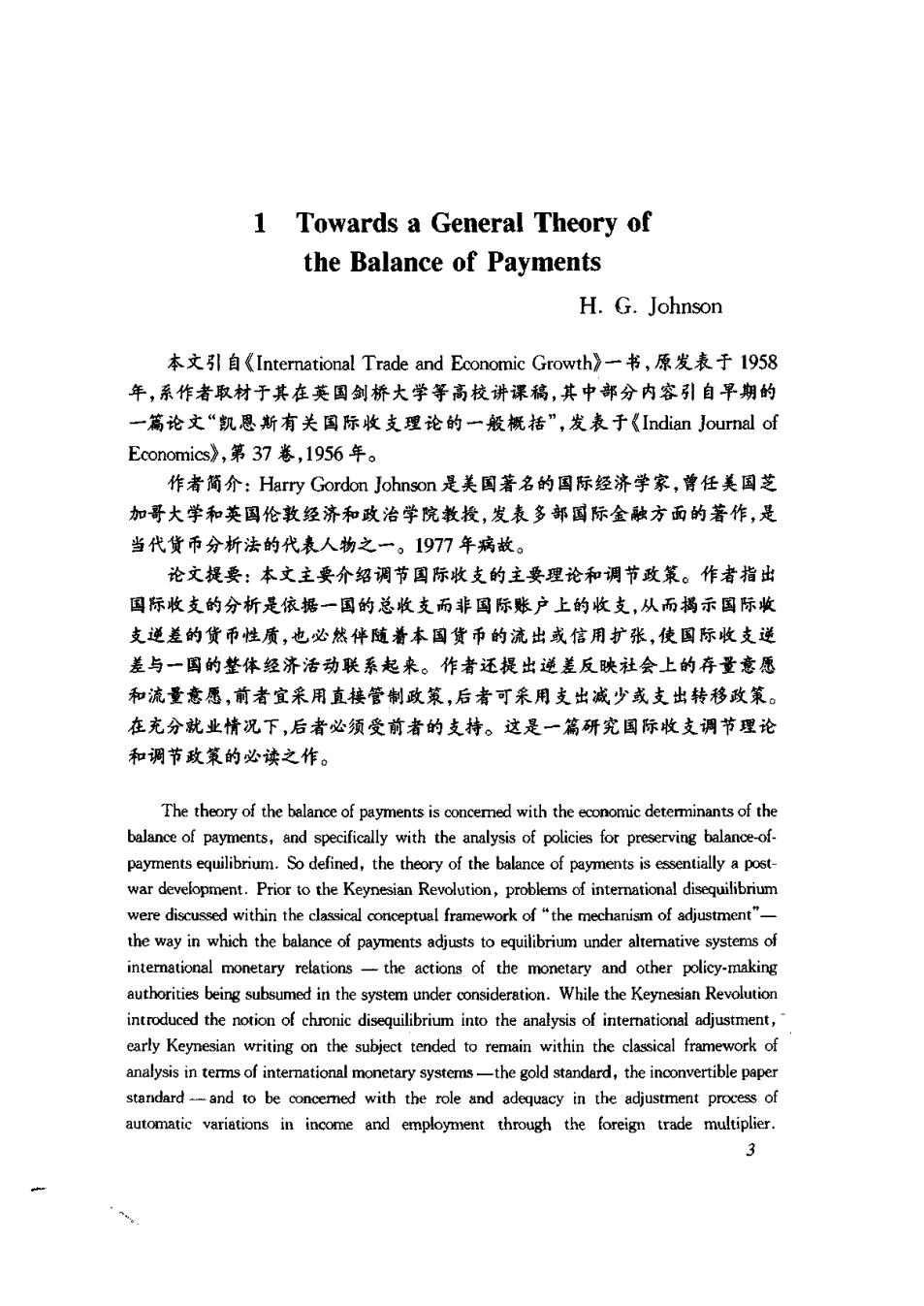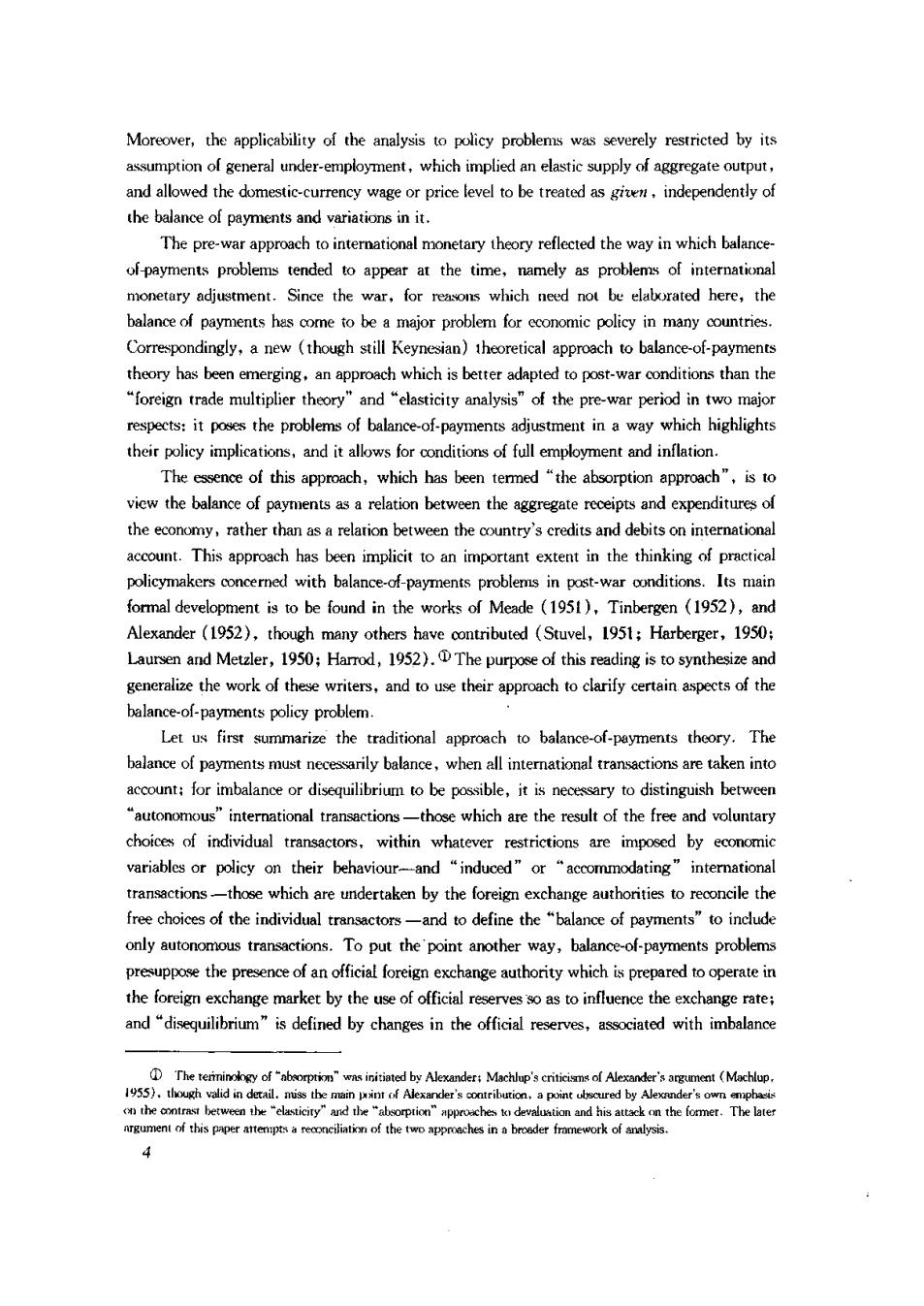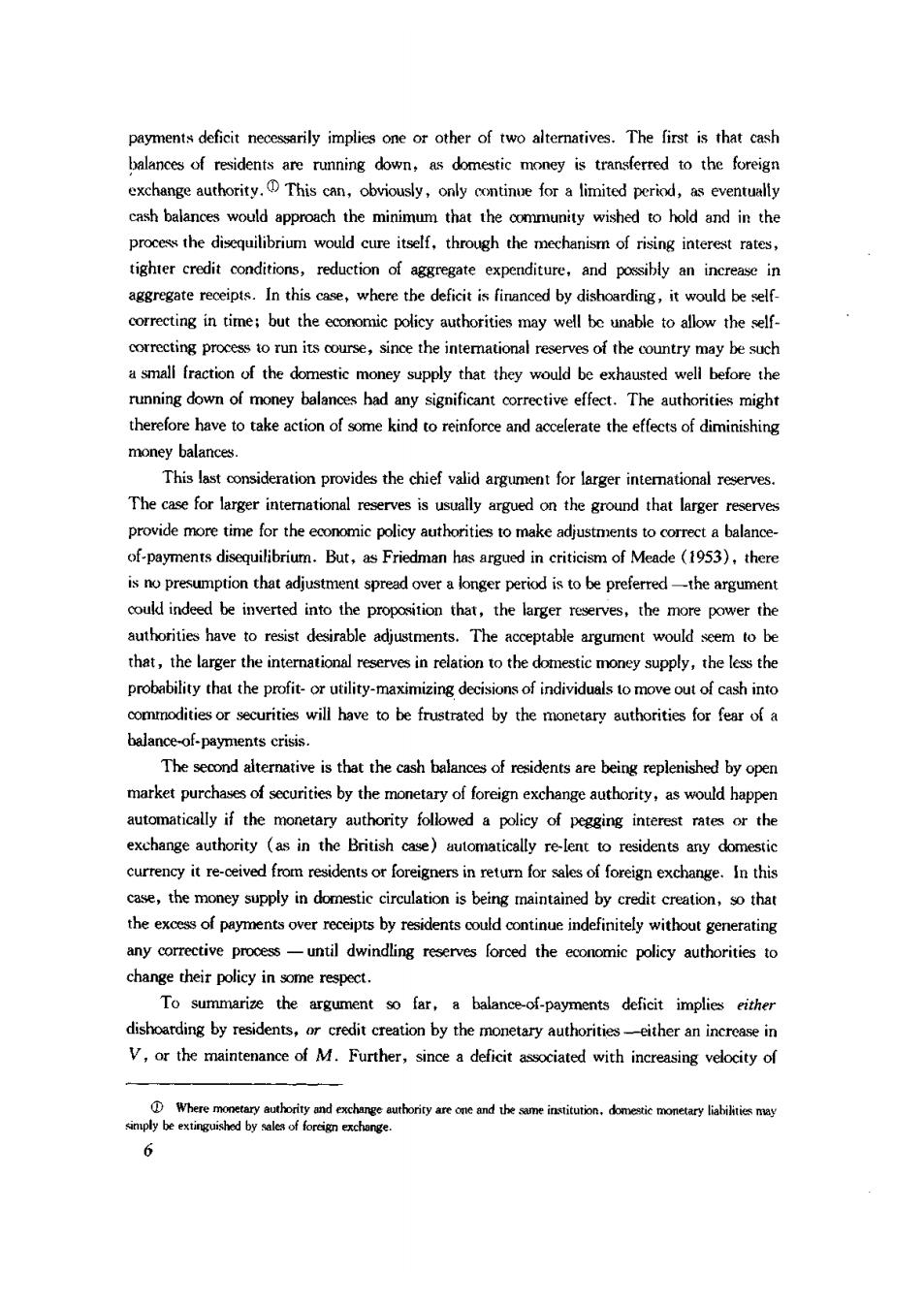
第一部分: 西方国际金融学专题论文

1 Towards a General Theory of the Balance of Payments H.G.Johnson 本文引自《International Trade and Economic Growth》一书,原发表于l958 年,系作者取材于其在英国剑桥大学等高校讲课稿,其中部分内容引自早期的 一篇论文“凯思斯有关国际收支理论的一般概括”,发表于《Indian Journal of Economics》,第37卷,1956年。 作者简介:Harry Gordon Johnson是美国著名的国际经济学家,曾任美国芝 加哥大学和英国伦敢经济和政治学院教授,发表多部国际金融方面的著作,是 当代货币分析法的代表人物之一。1977年病故。 论文提要:本文主要介绍调节国际收支的主要理论和调节政策。作者指出 国际收支的分析是依据一国的总收支而非国际账户上的收支,从而揭示国际收 支逆差的货币性质,也必然伴随着本国货币的流出或信用扩张,使国际收支逆 差与一国的整体经济活动联系起来。作者还提出逆差反映社会上的存量意愿 和流量意愿,前者宜采用直接管制政策,后者可采用支出减少或支出转移政策。 在充分就业情况下,后者必须受前者的支持。这是一篇研究国际收支调节理论 和调节政策的必读之作。 The theryofthe baceof paymet ishthedeteminant of the balance of payments,and specifically with the analysis of policies for preserving paymentsequilibrium.So defined,the theory of the balance of payments is essentiallya post- war development.Prior to the Keynesian Revolution,problems of interational disequilibrium were discussed within the of"the mechanism" the way in which the balance of payments adjusts to equilibrium under altemative systems of the actions of the monetary and other policy-making authorities being subsumed in the system under oieratin.While the Keynesian Revolution introduced the notion of chronic disequilibrium into the analysis of intemational adjustment, early Keynesian writing on the subject tended to remain within the classical framework of analysis in termsof interational monetary systems-the gold standard,the inonvertible pape standard-and to be concemed with the role and adequacy in the adjustment process of automatic variations in employment through the foreign trade multiplier. 3

Moreover,the applicability of the analysis to policy problems was severely restricted by its assumption of general under-employment,which implied an elastic supply of aggregate output, and allowed the domestic-currency wage or price level to be treated as giwen.independently of the balance of The pre-war approach to interational monetary theory reflected the way in which balance of payments problems tended to appear at the time,namely as problems of international etary adjustment. Since the war,for ron which need not b eaborated here,the balance of payments has come to be a major problem for conomic policy in many countries. Correpondingly,a new (though still Keyesian)heoretica approhto balance-of-payments "foreign trade multiplier theory"and"elasticity analysis"of the pre-war period in two major espects:it poses the problems of balance-of-payments adjustment in a way which highlights The cssence of this approach,which has been termed "the absorption approach",is to the economy,rather than as a relarion between the oury's credits and debitsoninteration account.This approach has been implicit to an important extent in the thinking of practical with balance-of-paymentsprobe ost-war onditions.Its min formal development is to be found in the works of Meade (1951),Tinbergen (1952),an Alexander (1952),though many others have contributed (Stuvel,1951;Harberger,1950; generalize the work of these writers,and to use their approach to clarify certain aspects of the balance-of-payments policy problem. Let us first summarize the traditional approach to balance-of-peyments theory.The balance of payments must necessarily balance,when all interational transactions are taken into account:for imbalance or disequilibrium to be possible,it is necessary to distinguish between se whichare the the free and onary choices of individual transactors.within whatever restrictions are imposed by economic variables or policy on their behaviour-and "induced"or"accommodating"international which are undertaken by the oreign the free choices of the individual transactors-and to define the "balance of payments"to include only autonomous transactions.To put the'point another way,balance-of-payments problems presenceof n official foreign exchange authority which is prepared tooperate i the foreign exchange market by the use of official reserves so as to influence the exchange rate; "is defined by changes in the official reserves,assciated with imbalance ms of Alexander's Machlup nent of this pnper attempts a reoonciliation of the two appmaches in a broeder framework of analysis

between the foreign receipts and foreign payments of residents of the country,where"resident" is defined to include all units domiciled in the the foreign exchang The"balance of payments"appropriate to economic analysis may then be defined as: B=Rr-P (1) where Ry represents aggregate receipts by residents from foreigners.and P represents aggregate payments by residents to foreigners.The difference between the two constitutes a surplus(if positive)or a deficit (if negative);a surplus is accmpanied by sales of foreign currency to the exchange authority by residents or foreigners in exchange for domestic currency.and conversely a deficit is financed by sales of domestic currency by residents or foreigners to the authority in exchange for foreign curency.To remedy a must be taken to increase reipts from foreigners and reduce payments to foreigners,or increase receipts more than payments,or reduce payments more than receipts;and conversely with a surplus (though the rectification ofa suplus is not generally regarded as a"balance-of payments problem") The"balance of payments"can,however,be defined in another way,by making use of the fact that all payments by residents reeipts by residents;in symbolsR=P Hence the balance of payments may be written B=R+R,-Pr-P,=R-P. (2) That is the balance of payments is the differene between agregate reeipts by residents and aggregate payments by residents.A deficit implies an excess of paymentsover receipts,and its rectification requires that receipts be increased and payments decreased,or that receipts increase more than payments.or that receipts decrease less than payments;and conversely with a surplus.In what follows,however,surpluses will be ignored,and the argument will be concerned only with deficits. The balance-of-payments deficit in tems of an excess of aggregate payments by by residents nstitutes poin for the generalization of the "absorption approach"to balance-of-payments theory-what might be two important aspects of a deficit-its monetary implications,and its relation with the aggregate activity of the economy-from which attention tends to be diverted by the traditional which le to fallacious anysis.These wo be discusdum beginning with the moneary impicationofa deficit. The excess of payments by residents over receipts by residents inherent in a balance-of. it is nee 5

payments deficit neesrily implics one or other of two altematives.The first is that cash balances of residents are runing down,domestic money is transferred to the foreign exchange authority.This can,obviously,only continue for a limited period,as eventually cash approch the minimum that wished tohold and in the process the disequilibrium would cure itself,through the mechanism of rising interest rates, tighter credit conditions,reduction of aggregate expenditure,and possibly an increase in correcting in time:but the economic policy authorities may well be unable to allow the self ,since the intemational ervesof the be such small fraction of the domestic money supply that they would be xhausted well before th running down of money balances had any significant corrective effect.The authorities might therefore have to take action of some kind to reinforce and accelerate the effects of diminishing money balances This last consideration provides the chief valid argument for larger interational reserves. The case for larger is usually arguedon the ground that larger reserve provide more time for the economic policy authorities to make adjustments to correct a balance of-payments disequilibrium.But.as Friedman has argued in criticism of Meade (1953).there is presumption spread overalonger period preferred-theargumen could indeed be inverted into the proposition that,the larger reserves,the more power the authorities have to resist desirable adjustments.The acceptable argument would be that,the larger the interation relation to the domestic money supply,the less the probability that the profit-or utility-maximizing decisions of individuals to move out of cash into securities will have to be frustrated by the moneary authorities for fear of a balanceof-payments crisis. The second alternative is that the cash balances of residents are being replenished by open market purchasesf by the monetary of foreign exchange authority,aswould happen automatically if the monetary authority followed a policy of pegging interest rates or the exchange authority (as in the British case)automatically re-lent to residents any domestic eurrency it re-ceivedont foreigners exchange.In this case,the money supply in domestic circulation is being maintained by credit creation,so that by without generating any corrective process-until dwindling reserves forced the economic policy authorities to change their policy in some respect. To summarize the argumentso far.abalance-of-payments deficit implies ithe dishoarding by residentsrcredit creation by the monetary authorities-cither an inc in V,or the maintenance of M.Further,since a deficit with increasing velocityof utbority are one and the saume institution.domestic monetary liabilities mey 6